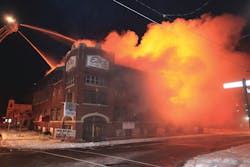On The Job New York: Two-Alarm Fire Destroys Historic Lodge in North Tonawanda
On Saturday, Dec. 10, 2011, a two-alarm fire destroyed the historic Elks Lodge in North Tonawanda, NY. The fire presented water-supply challenges to firefighters. The hydrant grid system terminated in the area of the fire, causing pumpers to rob water from one another and forcing the fire department to draft out of a canal. Asbestos contamination necessitated use of hazmat protection.
The four-story, 14,468-square-foot, masonry-and-wood building was constructed in 1921. The building had a pitched wooden roof covered with asphalt shingles. A bowling alley had been originally constructed in the basement but had been covered over with a floor in recent years. There were no fire protection or detection systems in the building.
The North Tonawanda Fire Department was dispatched to a reported fire at the Elks Lodge at 21 Main St. at 5:43 A.M. Engines 4 and 6, both 1,500-gpm pumpers, and Truck 1, a 100-foot aerial platform with a 2,000-gpm pump, responded with six firefighters under the command of Assistant Chief Joseph Sikora. Engine 4 arrived on scene at 5:45 A.M. and Firefighter Brandon Werth reported heavy smoke showing from the roof of the building. Engine 4 laid a 100-foot, four-inch supply line to the A/D corner of the building. Truck 1 was positioned on side A and was supplied by a 500-foot, four-inch line laid by Engine 6. Engine 6 was positioned at a hydrant at Main and Tremont streets and pumped to Truck 1.
Initial operations
Firefighters advanced two, 200-foot, 1¾-inch attack lines to the second- and third-floor lobbies from Engine 4. Firefighters encountered heavy smoke and heat in these areas. Crews operated inside the structure for 23 minutes before evacuating the building due to worsening fire conditions.
Sikora requested mutual aid from the City of Tonawanda Fire Department at 6:03 A.M. Tonawanda Engine 2, a 1,500-gpm pumper, and Ladder 1, a 100-foot aerial ladder with a 2,000-gpm pump, responded with 10 career and 20 volunteer firefighters.
Defensive operations were initiated at 6:08 A.M. after interior crews exited the building. North Tonawanda Truck 1 placed its two aerial master streams into operation. A 2½-inch attack line was also placed into operation. Tonawanda Ladder 1 was positioned on side D and set up for aerial master stream operations.
Tonawanda Engine 2 laid a 1,000-foot, five-inch line from a hydrant east of the building at Sweeney and Oliver streets and pumped to Ladder 1. This hydrant was capable of flowing only 750 gallons per minute, not enough water to effectively fight the fire. Engine 2 was repositioned to the Erie Canal and drafted with 30 feet of six-inch suction hose to supply Ladder 1.
North Tonawanda Fire Chief John Lapham declared the fire under control at 8:29 A.M. Mutual aid units were released at 11:20 A.M. North Tonawanda units left the scene at 2:30 P.M.
Conclusion
Ninety career and volunteer firefighters operated two aerials and three engines at the scene. More than one million gallons of water was used to extinguish the fire. In addition to the four hydrants on the municipal water system that were used, water was drafted from the Erie Canal. Two firefighters received minor injuries. Weather at the time of the fire was 20 degrees and clear. Damage was estimated at $217,000 to the building and $900,000 to the contents.
North Tonawanda fire and police investigators determined that the fire originated in a void space beneath a newly installed boiler on the fourth floor. The cause of the fire was undetermined. The rapid fire spread was attributed to the large amount of lath wood and gilded detail throughout the structure. Asbestos contamination necessitated the complete demolition of the building.
Lessons learned
The hydrant grid system terminated in the area of the fire. This caused pumpers to pull water from other apparatus, but was overcome by drafting out of the Erie Canal. The fire department is researching the possibility of installing dry hydrants in the downtown business district to establish additional water supplies in the area.
JAY K. BRADISH/IFPA, Firehouse® news editor, is a former captain in the Bradford Township, PA, Fire Department. He has been a volunteer firefighter and fire photographer for more than 25 years.
NORTH TONAWANDA FIRE DEPARTMENT
Chief: John C. Lapham
Personnel: 38 career firefighters, 50 volunteer firefighters
Stations: 6
Apparatus: 3 pumpers, 1 aerial, 1 command car, 1 light rescue, 1 investigation unit, 2 ALS units, 1 reserve pumper, 1 reserve light rescue
Population: 31,568
Area: 10.2 square miles






